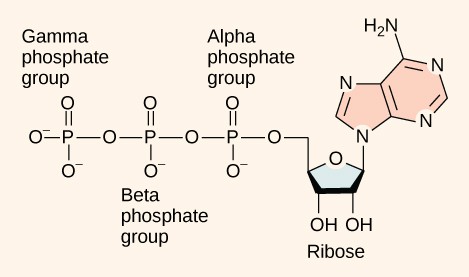Atp Releases Energy When It Bonds Between Its Phosphate Groups
An ATP molecule is unstable and primed to release energy because its ______ groups are negatively charged and repel each other. Most cells only store enough ATP for _____ of activity.
Key to its ability to store and supply energy.
. YOU MIGHT ALSO LIKE. Click card to see definition. ATP releases energy when it _____ bond between its phosphate groups.
This characteristic of ATP makes it exceptionally useful as a basic energy source for all cells. When a cell has energy available it can store small amounts of it by adding phosphate groups to ADP molecules producing ATP. Energy provided by ATP is used in.
ATP releases energy when the bond between the second and third phosphate groups is broken. During the hydrolysis of ATP the last phosphate group is transferred to another molecule thus breaking the phosphate bond. ATP is a nucleoside triphosphate with the structure of a nitrogenous base adenine a ribose sugar and three serially bound phosphate groups.
As its name suggests adenosine triphosphate is comprised of adenosine bound to three phosphate groups Figure. For example 60kJmol 24 k B T for hydrolysis of PEP phosphoenolpyruvate but only 13 kJmol 5 k B T for glucose-6-phosphate BNID 105564. Which of the following best explains how the structure of ATP helps provide energy to the cell.
Cells release energy from ATP molecules by _____ a phosphate group. Terms in this set 11 energy. Adenosine is a nucleoside consisting of the nitrogenous base adenine and a five-carbon sugar ribose.
Tap card to see definition. Active transport to contract muscles to make proteins and much more. Adenosine triphosphate ATP one of the most important compounds that cells use to store and release energy.
Adenosine triphosphate or ATP consists of a sugar called ribose the molecule adenine and three phosphate groups. Adenosine triphosphate ATP is the energy currency for cellular processes. Tap again to see term.
The removal of one phosphate group releases 73 kilocalories per mole or 306 kilojoules per mole under standard conditions. Main chemical compound cells use for energy. ATP contains energy in the chemical bonds between its phosphate groups.
In addition to providing energy the breakdown of ATP through hydrolysis serves a broad range of cell functions including signaling and DNARNA synthesis. When the chemical bonds within ATP are broken energy is released and can be harnessed for cellular work. Energy is released from ATP by the breaking of the phosphate bond states the University of Illinois at Chicago.
When ATP becomes ADP it loses a. ATP stores energy in the bonds between its phosphate groups. Plants that captures the energy from sunlight.
It has an adenosine backbone with three phosphate groups attached. Click again to see term. ATP is the main carrier of energy that is used for all cellular activities.
ATP h2O - ADP P energy. ATP is commonly referred to as the energy currency of the cell as it provides readily releasable energy in the bond between the second and third phosphate groups. When ATP is hydrolyzed and converted to adenosine diphosphate ADP energy is released.
ATP provides the energy for both energy-consuming endergonic reactions and energy-releasing exergonic reactions which require a small input of activation energy. Ability to do work. Because it offers rapidly releasable energy in the link between the second and third phosphate groups ATP is usually referred to as the cells energy currency.
See answer 1 Best Answer. Likewise which process provides the energy used to make ATP from ADP. Tap again to see term.
When ATP hydrolysis an exergonic reaction provides the energy for a simultaneous endergonic reaction this is an example of ______ reactions. ATP is the primary energy currency of the cell. Common metabolites exhibit a big difference in the energy released upon hydrolysis of their phosphate group.
Releases energy when it breaks bonds between its phosphate groups. In Table 1 we collect information on the energetics of reactions involving. See answer 1 Best Answer.
ATP can easily release and store energy by breaking and re-forming the bonds between its phosphate groups. ATP can easily release and store energy by breaking and re-forming bonds between its phosphate groups.

Atp Adenosine Triphosphate Openstax Biology
Which Bond Must Break In Atp For Energy To Be Released Quora

Comments
Post a Comment